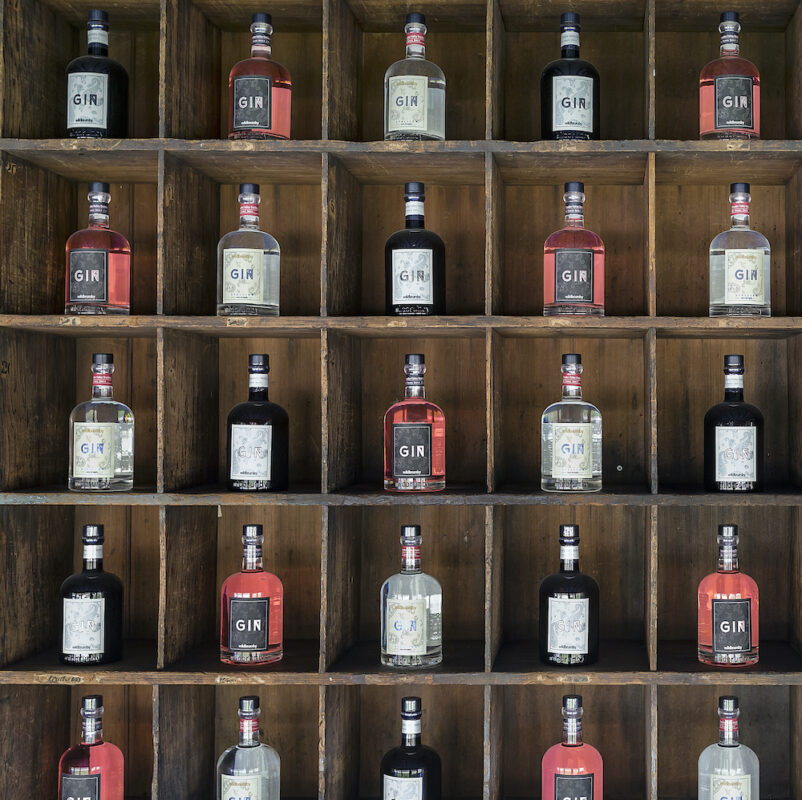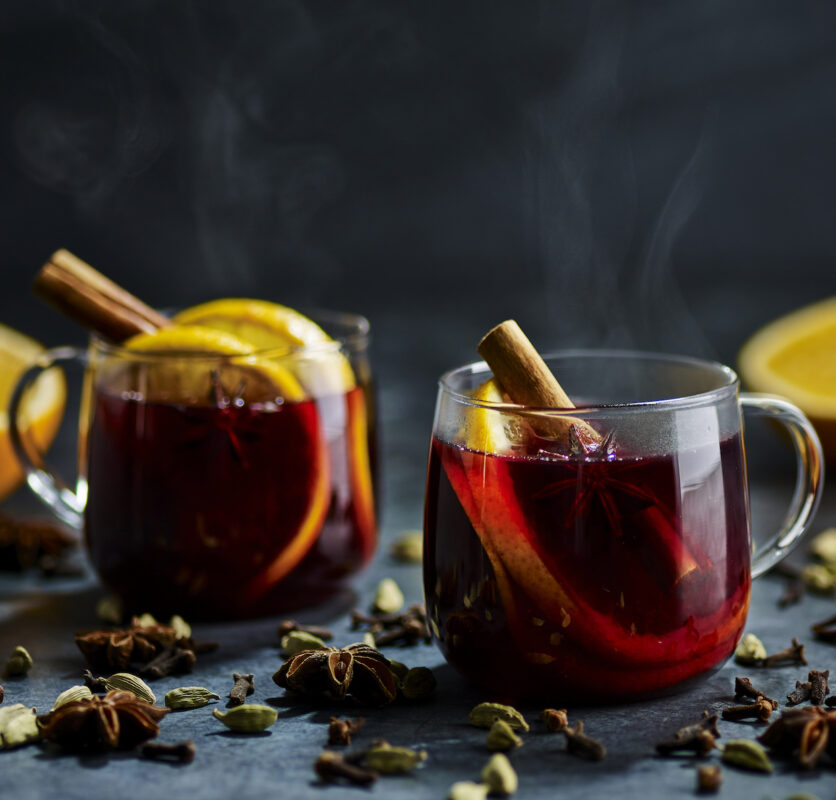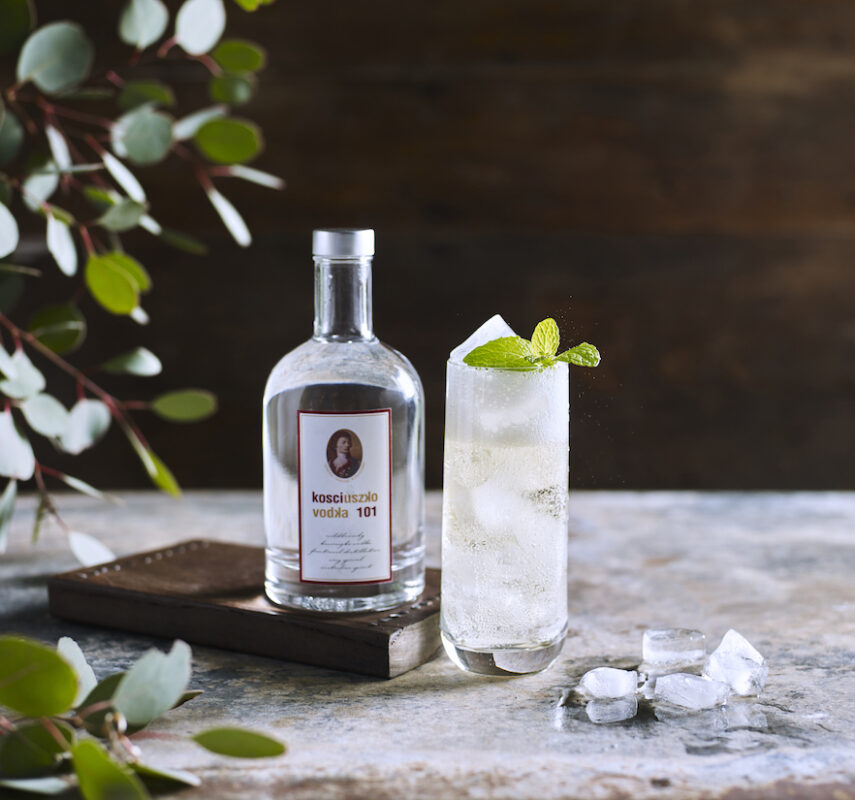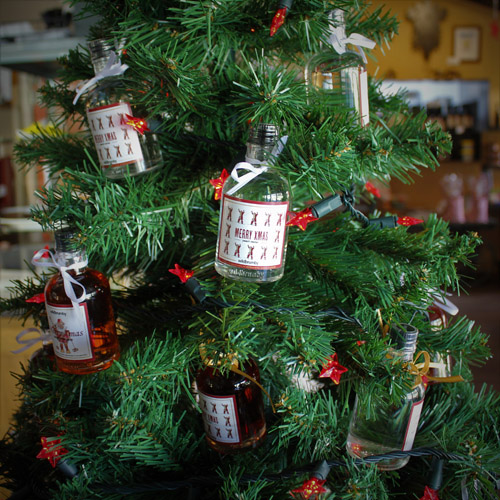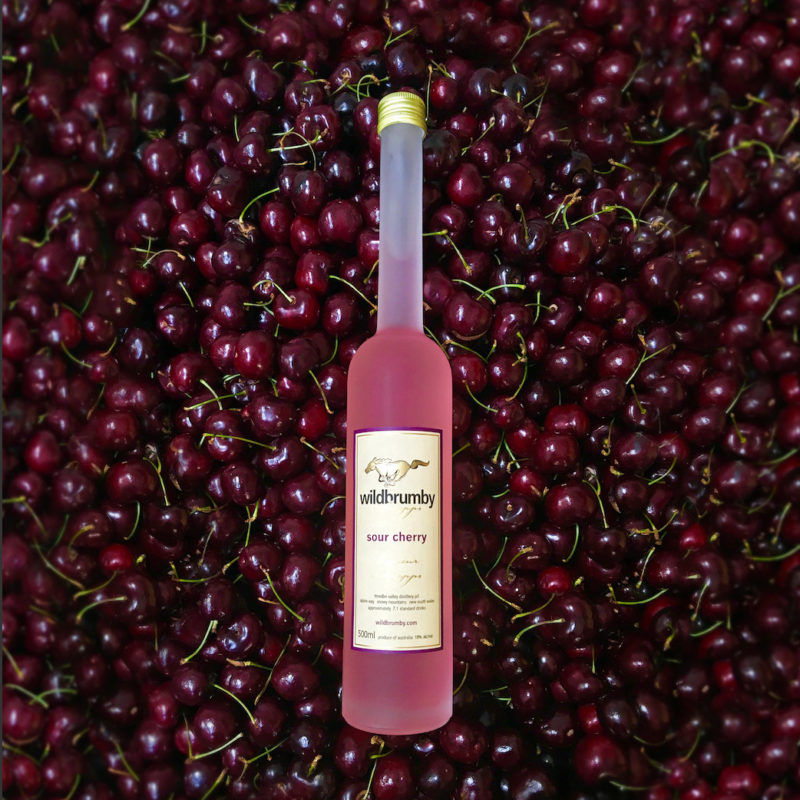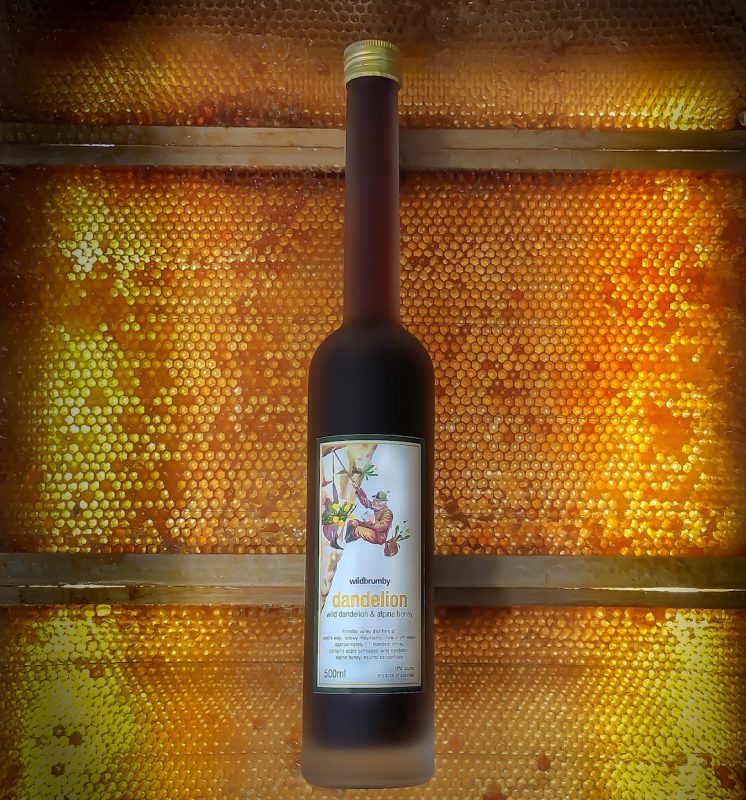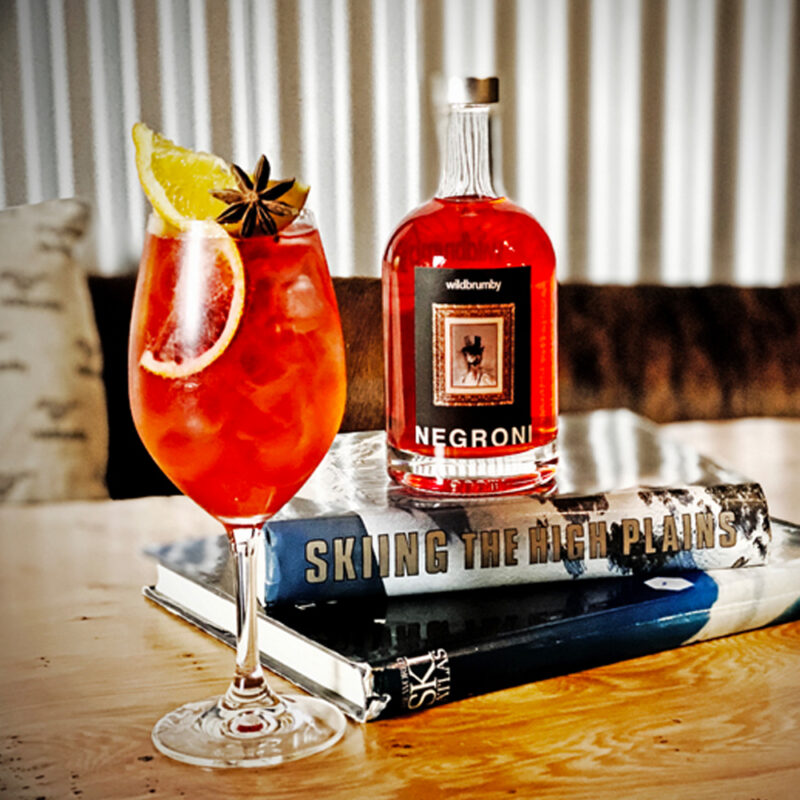Category Archives: Uncategorized
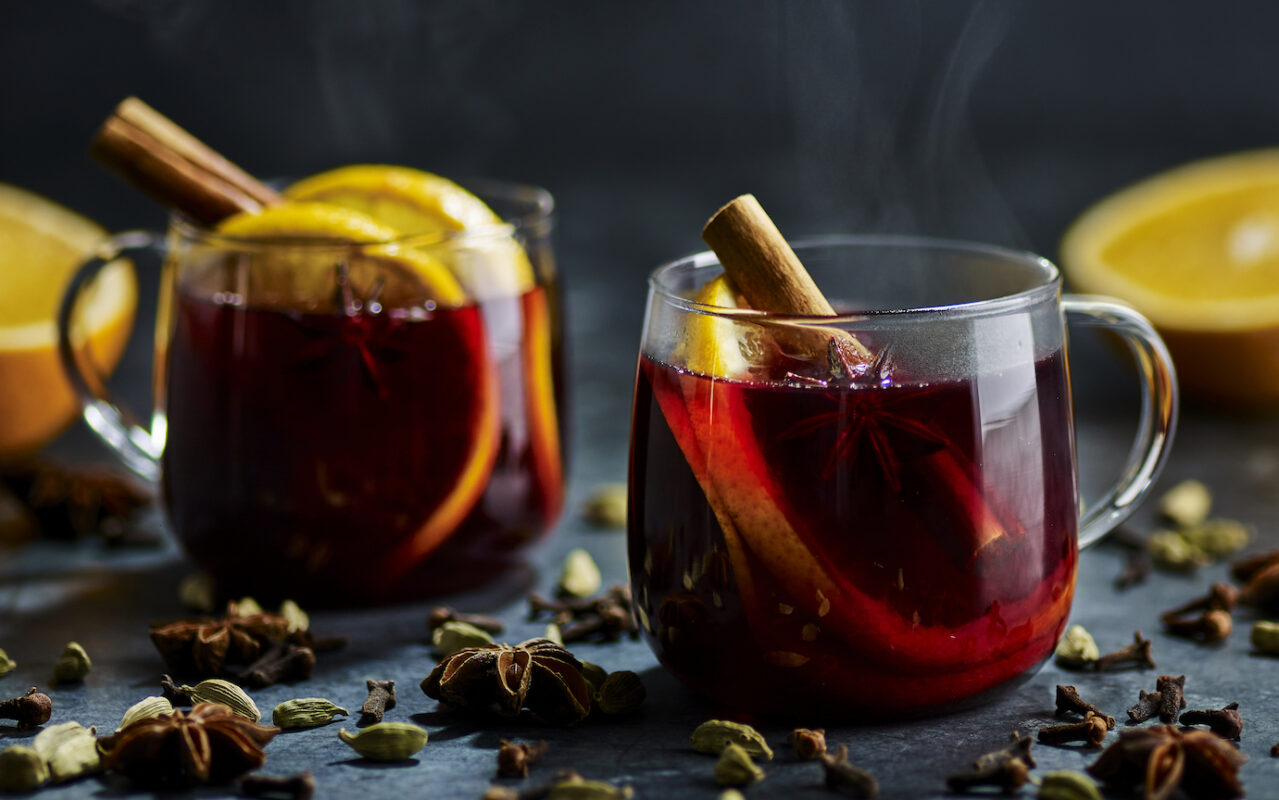
You can’t have winter without a mug of piping hot glühwein.
This sweet, warming blend of red wine, herbs and winter spices will have you singing from the snow-capped mountaintops.
In fact, glühwein has been a traditional winter staple throughout western Europe for around 600 years. And it is not difficult to deduce why it has been popular for so long.
Glühwein is German for ‘glow wine’. As the name suggests, its warm temperature and boozy base will have you glowing with warmth from head to toe.
This winter brew is both soul warming and simple to put together (with the right ingredients) and is as moreish as anything.
Now, we’re not usually ones to mess with a classic – Oh, who are we kidding? We love to shake things up!
But we feel we’ve created the holy grail of glühwein recipes. So, what makes our wildbrumby glühwein so delectably different?
It should come as no surprise that the secret behind our incredibly popular glühwein is one of our most loved schnapps – our pink lady apple schnapps!
The fruity, sweet elements of our pink lady apple mean two things: a little more booze in your mug. And a whole mouthful of sweet, apple flavour balanced with the delectably herbaceous and spiced red wine notes.
Whether you’re stuck at home or hitting the slopes this winter, our bottles of wildbrumby glühwein are ready to take you on a winter flavour journey.
To make the most of it, we’ve put together pairing ideas and the perfect guide to serving up a warm mug of winter goodness.
How to Pair it
Our wildbrumby glühwein is the ultimate glow up to any winter dinner party. Just making this delicious winter warmer will invite a scented dimension of spice and sweet wine into your home.
If small après get-togethers are more your style, try serving this warm cocktail with a platter of soft cheeses and sliced cured meats. Our wildbrumby glühwein’s spiced and sweet fruit elements contrast perfectly with salty, meaty foods.
Adding a few pink lady apple slices or orange marmalade to your grazing board will tie in all these elements flawlessly – Your friends will think you’re a flavour pairing extraordinaire!
This drink pairs a treat with hearty, traditional dishes too. Think a pork schnitzel the size of a dinner plate served with Keffler potatoes and cranberry sauce, or a big bowl of warm apple strudel slowly melting a dollop of fresh cream. All the while, you’re sipping on a warm mug of delectable glühwein.
Put it all together for Christmas in July celebrations, and you’ll feel as if you’re feasting in a remote chalet surrounded by snow-capped mountains in the Austrian Alps.
How’s that for a staycation?
How to perfect it
The whole warming process should take no longer than four minutes on low heat and will create around four generous servings.
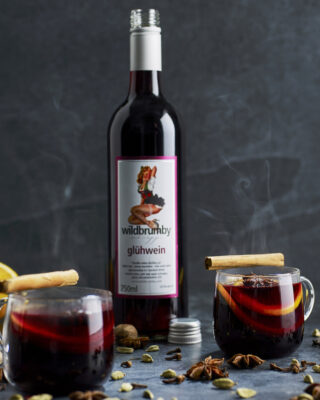
You’ll need:
wildbrumby glühwein
star anise
cinnamon sticks
1 orange
Method:
Empty your 750mL bottle of wildbrumby glühwein into a pot. Add in two star anise, a cinnamon stick and four orange wheels before slowly heating over the stove.
Be careful not to bring your glühwein to a boil – doing so could reduce the wine’s potency and flavour.
Once warmed, your wildbrumby glühwein is ready to be served in pre-warmed mugs. Garnish each warm mug of glühwein with an orange slice and cinnamon stick, and enjoy by a roaring fire.
Now, here’s a little trick.
To keep any steaming cocktail piping hot for longer, you’ll want to pre-warm your mugs or heat resistant glasses. The process couldn’t be simpler, and it can be done whilst preparing your wildbrumby glühwein. Simply fill your vessel of choice with hot water and allow the heat to warm it up. Just remember to discard the water before serving.
Enjoy!
We’re calling it. Autumn is for Australian vodka!
Our Kosciuszko Vodka was born in the Snowy Mountains – just 22km from Australia’s highest peak, Mount Kosciuszko. And because it is blended with pristine snow melt, the mountains’ beautiful, yet volatile, nature lives in its DNA.
So why is our vodka the perfect spirit for autumn?
It combines a clean, crisp flavour profile with a smoothness that only premium vodka is known for – perfect for the in-between time of the year when you’ve retired your swimmers to the back of the cupboard, but you’re just not ready to pull out those winter sweaters.
And if you’re anything like us, those wardrobe problems are mirrored in our choice of afternoon tipple – with fruity fixes packed with crushed up ice long gone, but hot toddies not yet on the horizon.
So for this weather-confused season we bring you four vodka-based cocktails that we think are ‘just-right’ for this in-betweeny time of year, so you can make best use of this versatile spirit!
Devil Mary
60mL Tomato juice ½
30mL Devil Tongue ¼
30mL Vodka ¼
15mL lemon juice
3 dashes Worcester sauce
2 dashes tabasco
Celery, lemon, olives, salt & pepper
Wow, that’s a lot of ingredients! But the Devil Mary couldn’t be simpler. Build this Sunday morning classic in a tall glass filled with ice, and garnish with a celery stick, lemon wedge, olives and a dusting of salt and pepper.
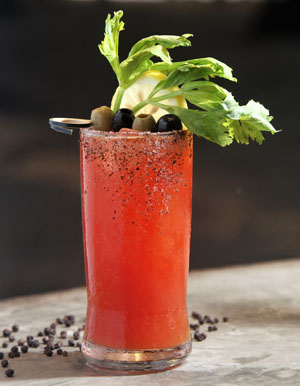
Sour Apple Martini
60ml Sour Apple Schnapps
30ml Kosciusko Vodka
Lemon twist
Add all your schnapps and vodka to an ice-filled mixing glass and stir until very cold. Strain into a chilled Martini glass and garnish with a twist of organic lemon.
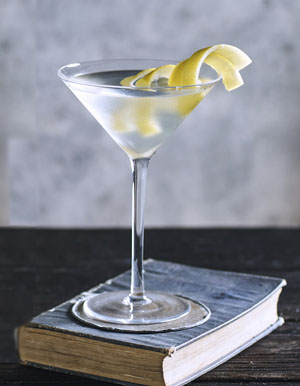
Autumn Highball
Vodka 45ml
Ginger ale
Macadamia syrup 20ml
To prepare the syrup, add the following ingredients to a mixing jug and allow to infuse as the mixture cools. Leave the mixture for 15 minutes before straining out the macadamia solids.
Brown sugar 1/3 cup
White sugar 1/3 cup
Finely chopped macadamia 1/3 cup
Hot water 1/3
Build drink over ice in a tall glass and garnish with an orange peel.
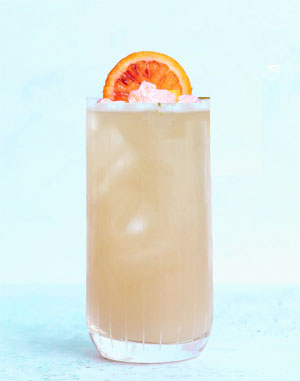
Visit the wildbrumby online shop to find all the ingredients (and more) for our Autumn cocktails.

We’ve got all the ingredients to add a dash of magic to your festivities this year.
Fine food and drink are the hallmarks of the silly season, and while we’ve never let a lack of snow get in the way of the great Australian Christmas, traditional mulled beverages just don’t cut it this time of the year.
For most of us, summertime celebrations are spent beside the pool or the barbie where ice-cold beer and cocktails are the stars of the show.
So whether it’s a sparkling peach bellini, sour cherry martini, or a limited-edition pink gin & tonic that jingles your bells, we’ve got all the ingredients to make yours a magical one.
Here are four of our go-to cocktails for a schnappy, summertime Christmas.
Black Label Christmas Gin
Born through blending vibrant Christmas flavours with our award-winning Rubus Patch Gin, this is a gin you’ll wish someone would gift to you.
Our Black Label Gin has vivacious notes of festive fruits and elderflower paired with homegrown raspberries, juniper, and a trio of citrus. And like all our gins, this one is balanced with pristine alpine water and native botanicals found in our own backyard — the Snowy Mountains.
You can enjoy this lusciously pink gin over ice or with a quality tonic. But the best way to enjoy a festive fruit-forward gin? In a big glass of our Holy Hoity Toity cocktail while you lounge around in a sun-bathed beach chair. Heaven!
Serve to your party guests or be the best gift-giver and surprise a loved one with a bottle under the Christmas tree. Just remember, you deserve one too.
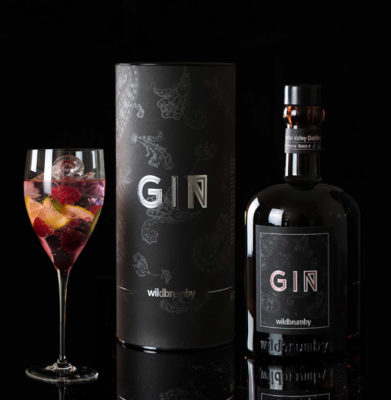
Holy Hoity Toity
Like a classic gin and tonic but with a festive twist. Our wildbrumby Black Label Gin is the centrepiece of a cocktail with all the sleigh bells and whistles. Sweet, fruity and paired perfectly with a traditional pavlova – your Christmas party guests will be coming back for seconds.
Ingredients:
30mL wildbrumby Black Label Gin
Soda Water and Lemonade (or Elderflower Tonic)
Raspberries
Cucumber
Lemon
Method:
Steep raspberries in wildbrumby Black Label Gin for at least an hour before serving. Prepare garnishes by thinly slicing lemon wheels and cucumber strips.
Add ice, garnishes, soaked raspberries and wildbrumby Black Label Gin to a large wine glass. Top with either elderflower tonic, or soda water and a splash of lemonade. Shop for Black Label Gin here.
Cherry Sour
Nothing says Christmas quite like cherries and this luscious cocktail is no exception.
Our Cherry Sour strikes the perfect balance between the sweet and sour elements of our seasonal Sour Cherry schnapps with cherry notes from our Christmas gin adding depth to this festive favourite.
Ingredients:
60mL wildbrumby Sour Cherry schnapps
30mL wildbrumby Christmas gin
20mL fresh lime juice
1 teaspoon wildbrumby morello cherry syrup (or make your own syrup from cherry jam)
30mL aquafaba chickpea juice (or 1 fresh egg white if preferred)
Method:
Add all ingredients into a cocktail shaker. Shake dry (without ice) for 15 seconds, then add ice and shake until cold.
Double strain into an ice filled tumbler and garnish with morello cherries.
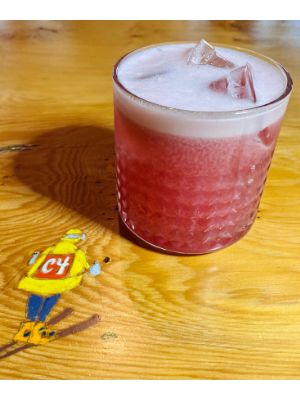
Peach Nectar Bellini
Inspired by 15th Century paintings of pink togas and holy garments – the Bellini is sophisticated in flavour and simple to create here for extravagant celebrations!
It’s been a long 2020 and we’re all itching to ring in a better New Year. So, pop the cork on our wildbrumby Brut and get those bubbles flowing.
All you need now is good company to share the special occasion and our award-winning wildbrumby Peach Nectar Schnapps.
You can find our Bellini Pack ready-to-go here.
Ingredients:
20mL wildbrumby Peach Nectar Schnapps
wildbrumby Brut
peach
Method:
First, garnish your chilled champagne flute with a slice of fresh peach. Pour wildbrumby Peach Nectar Schnapps into your glass and top with wildbrumby Brut.
Cheers from the wildbrumby team!
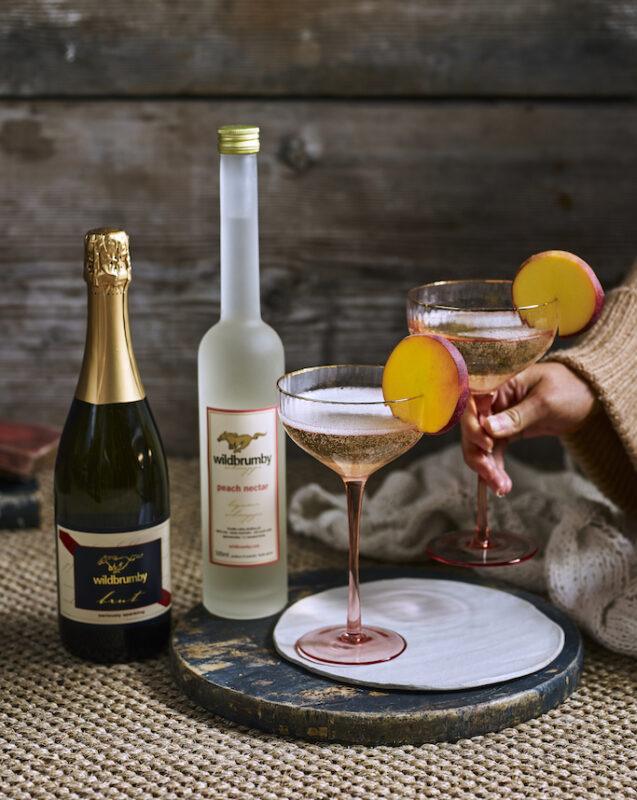
Sour Cherry Martini
What would Christmas in Australia be without buckets of rich red cherries?
Our wildbrumby Sour Cherry Schnapps is a seasonal addition to our schnapps range —providing this martini with true tart, candied cherry notes.
Give the gift of good drinks to your martini-loving friend with our Sour Cherry Martini Pack here.
Ingredients:
60mL wildbrumby Sour Cherry Schnapps
30mL wildbrumby Kosciuszko Vodka
Maraschino Cherry
Method:
Add ice, wildbrumby Sour Cherry Schnapps and wildbrumby Kosciuszko Vodka to a mixing glass and stir for 15 rotations. Strain into a chilled martini glass and serve with a single maraschino cherry.

Brad and Monika Spalding are proud to have been named ‘Business of the Year’ at the Jindabyne Citizen Award Ceremony on Australia Day 2022.
The Australia Day awards were held at John Connors Oval to celebrate the achievements of local citizens and businesses, and wildbrumby distillery was chosen for its outstanding contribution to tourism and arts in the Snowy Monaro region.
The event was supported by Snowy Monaro Regional Council and The National Australia Day Council as part of the National Australia Day Celebrations.
Bring out the champagne glasses – it’s sour cherry schnapps season!
Christmas is all about great company and fabulous food. Lunch tables overflow with prawns and sweet, heart-shaped cherries. Their pits decorating the table come dinner time.
So, what happens to their smaller, less common cousins – the sour, morello cherry?
These deep ruby morsels are gifted with a complex flavour that we believe was made for our sour cherry schnapps!
Sour cherries, like the morello cherry have been used in liqueurs all over Europe for centuries. The most famous being Kirshwasser, meaning “cherry water”, from the Black Forrest region of Germany.
You guessed it. Sour cherry is the beautifully tart and tempting schnapps responsible for the delicious black forest cake. But could you imagine a cherry topped pavlova drizzled with our seasonal sour cherry schnapps!?
The possibilities are endless with this deliciously bittersweet treat. Here are a few cocktail recipes to get you cheers-ing to cherry this Christmas!
Kirsch Royale
As a Christmassy riff on the French ‘Kir Royale’, this cocktail is all about celebration. The star ingredient? A generous pour of our seasonal sour cherry schnapps.
This is the perfect cocktail to serve to friends just as the Christmas crackers are pulled and the jokes are shared.
And the best part about our Kirsch Royale is that you’ll have one at your fingertips in two easy steps – Let’s leave the complicated recipes to the food this year.
Ingredients:
20ml wildbrumby sour cherry schnapps
wildbrumby brut
morello cherries
How to make it:
To be cheers-ing to cherry all through to Christmas dinner, first place your morello cherry into a champagne flute and add our wildbrumby sour cherry schnapps.
Next, tilt the champagne flute on a 45-degree angle and fill with our wildbrumby brut. This will result in an evenly mixed cocktail that is ready to serve in seconds.
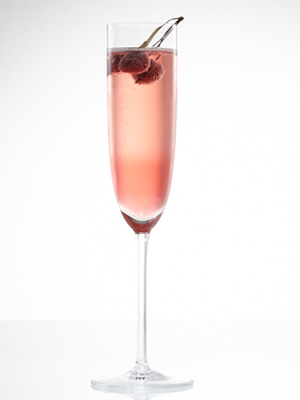
Sour Cherry Martini
It wouldn’t be a wildbrumby celebration without a martini. And our seasonal sour cherry schnapps is the ingredient that takes our signature martini recipe from party favourite to the Christmas cocktail everyone will want to sip.
In this cocktail you’ll find a lip-smacking tartness and candied cherry notes. (Have a friend obsessed with martinis? We have that Sour Cherry Martini Pack they didn’t know was on their Christmas wish list.)
Ingredients:
60mL wildbrumby Sour Cherry Schnapps
30mL wildbrumby Kosciuszko Vodka
morello cherry
How to make it:
Set up your chilled martini glass with a single morello cherry. Then, bring out your cocktail mixing glass and fill it to the brim with ice. Add our sour cherry schnapps and wildbrumby Kosciuszko vodka, and stir for 15 rotations.
Strain the contents of your cocktail mixing glass into your chilled martini glass. Enjoy!
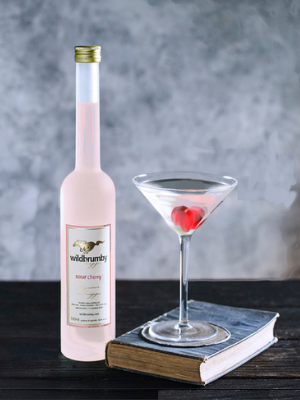
Sour Cherry Sling
The Singapore Sling, a brilliantly fruity and pink cocktail, was invented in Singapore in the early 1900’s and has been a summertime classic ever since.
Some versions of the long forgotten ‘original recipe’ call for pineapple juice. However, our version combines the citrus notes of fresh lemon and orange, giving this cherry-forward drink an extra punch of tartness.
Sipping this cocktail by the pool or whilst on BBQ duty is one way to beat that summertime heat.
Ingredients:
30mL Classic Gin
30mL Sour Cherry
15mL fresh lemon juice
15mL fresh orange juice
morello cherries
wildbrumby morello bitters (or Angostura bitters)
soda water
How to make it:
The key to making the best Singapore Sling is to use fresh and quality ingredients. First, squeeze at least 15mL of fresh lemon juice and 15mL of fresh orange juice. Then prep your garnish by pinning two morello cherries using a cocktail pin.
Fill a bar shaker with ice and pour in the lemon juice and orange juice, followed by our wildbrumby classic gin and our cherry schnapps. Shake till frost forms on the outside of your bar shaker and strain into an ice filled Collins glass. Top with soda water.
Place your pinned cherries on top of your glass and add a tiny dash of morello bitters (available from our distillery door). And if you don’t have a bar shaker at home, simply build it straight into your glass.
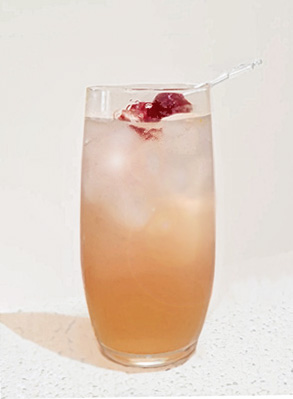
wildbrumby seasonal products are available from our online shop or distillery door for limited periods only.
Wildflowers are in bloom, the sun is out, and the mountains are singing for adventure.
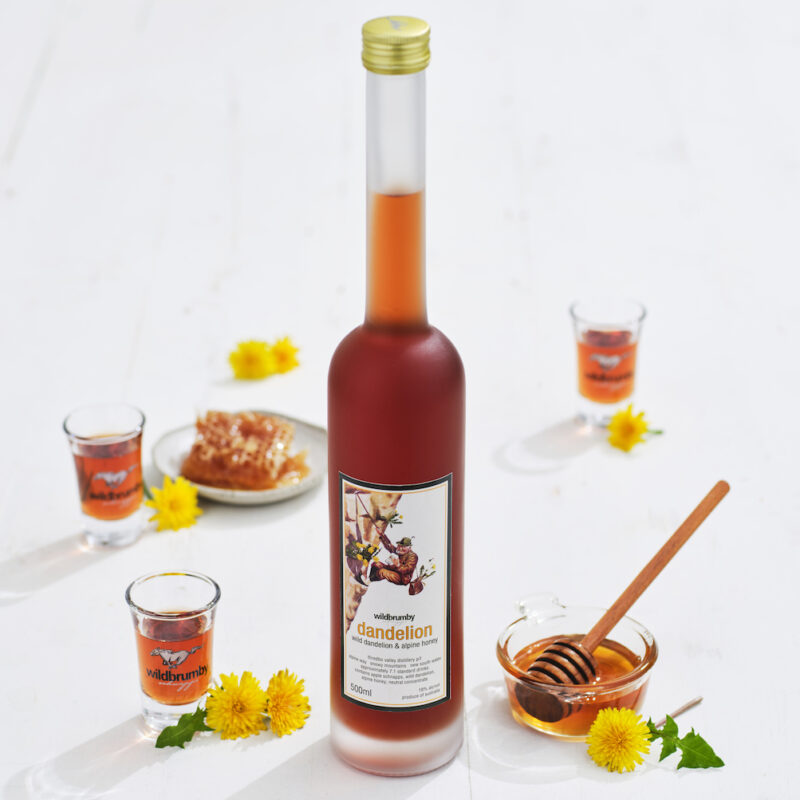
Spring has sprung and we’re celebrating with a floral, herbaceous and honey-sweet treat – our Dandelion & Honey schnapps.
Incorporating wild, handpicked dandelion flowers and local alpine honey with a base of our Pink Lady Apple schnapps. This is a seasonal schnapps made to be savoured for as long as our dandelions are in bloom.
You may be asking yourself, why dandelion? This vibrant yellow flower is highly aromatic and known as one of the most common edible flowers.
In teas and drinks, dandelion gives off a rich herbaceous and floral flavour often served alongside honey and lemon.
Local alpine honey is a key ingredient in our Dandelion & Honey schnapps too.
As bees busily venture from plant to plant, the taste of the snowy mountains in spring is collected into each drop of their gorgeous golden honey.
For us, the vibrant notes of wildflowers and local alpine honey are the true flavours of spring. So, where does the idea of floral schnapps come from?
Herbs and flowers, like dandelion, have a long history in liquor creation. Particularly in Western Europe where many traditional alcoholic beverages consumed in springtime, and beyond, are herbal liqueurs and aromatised fortified wines.
Today, you’re bound to come across plenty of cocktails celebrating springtime with herbaceous and floral flavours.
Here’s how we like to drink it:
Our Dandelion & Honey schnapps is delectable served neat or over ice. You can also try it as a boilermaker with your favourite lager after a long mountain bike ride or enjoy it in a simple cocktail like our Angry Bee. What better way to celebrate spring than with a floral and honey forward refresher?
How to make the Angry Bee:
Ingredients:
wildbrumby Dandelion & Honey schnapps 60mL
Fresh Lemon Juice 15mL
Soda Water
An edible flower
Method:
Fill a highball glass with ice and pour in our wildbrumby Dandelion & Honey schnapps and fresh lemon juice. Stir in ingredients and top with high-quality soda water.
Want to make this drink extra special? First, add ice to your highball glass and fill it halfway with soda water. To a cocktail shaker, add ice, fresh lemon juice, our wildbrumby Dandelion & Honey schnapps and shake well.
Using the cocktail shaker will thoroughly mix these ingredients and creates a soft texture that tastes phenomenal and is sure to impress your friends.
Strain the contents of your cocktail shaker into your highball glass and top with extra soda water if needed. Garnish with your favourite edible flower – our pick is the dandelion, of course!
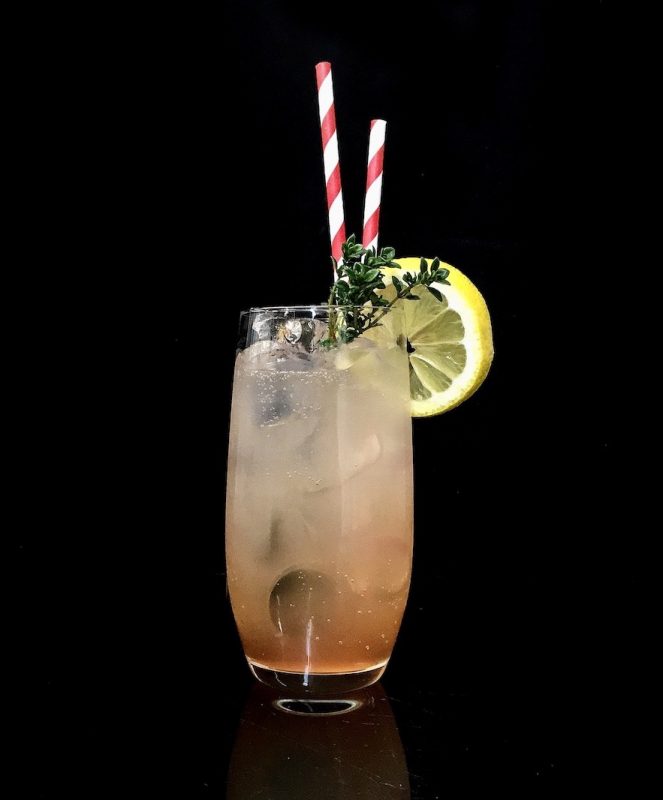
*wildbrumby seasonal products are available from our online shop or distillery door for limited periods only.
Whether you’re at a party or just kicking back on a sunny afternoon, everyone loves a cheeky cocktail or two! But sometimes a full standard drink isn’t what we’re after.
Plenty of Australians are choosing to drink less, but drink better. Whatever the reason for being alcohol-volume conscious, no one wants to suffer flavourless fizzy drinks or mocktail cordials.
This is where the low-abv cocktail (low-alcohol-by-volume) comes in.The key ingredient to all of them? Our wildbrumby schnapps of course!
We’ve put together a list of flavoursome low-abv cocktails that will keep you present for the party.
Schnapperol Spritz
5.8% abv
The Schnapperol Spritz is cocktail with a fresh, lively character that truly melds the best of both seasons, blending our wildbrumby winter negroni with the deep citrus notes of Fever Tree blood orange soda. It’s ideal for those moments when you’re soaking up the spring sun surrounded by good company.
Ingredients:
60mL Wildbrumby Negroni
200mL Fever Tree Blood Orange Soda
Method: Fill a big wineglass with lots of ice, add Negroni. Top up with Fever Tree Blood orange soda and garnish with a slice of orange and/or blood orange and star anise.
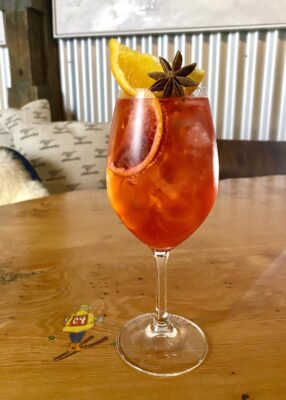
Pear William Fizz
5.0% abv
What goes better with our wildbrumby pear william schnapps, than more real pears!? Pears are the perfect addition to this classy yet simple cocktail. This drink dials up luscious fruit and vanilla notes without going overboard on alcohol volume.
Serve it with a spoon for a sweet pear treat waiting at the bottom your glass!
Ingredients:
45mL wildbrumby pear william schnapps
120mL Soda Water
Vanillin Sugar
Half a Pear
Method: Chop half a pear into small cubes and toss in a sprinkle of vanillin sugar. Fill 1/3 of tumbler glass with the cubed pears and ice. Pour in wildbrumby pear william schnapps and stir. Top with soda water and serve with a spoon on the side.
If you’re after a higher abv cocktail, add 30ml wildbrumby classic gin to the pear william fizz before topping with soda water.
You can find our wildbrumby pear william here.
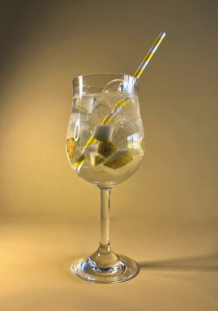
Donner & Blitz
5.2% abv
We can’t finish this list without including an old-time favourite – our devil’s tongue schnapps and ginger beer combination.
Enjoy this bitey drink after a long day on the slopes or as a summer afternoon refreshment. It is truly a year-round drink.
Ingredients:
60mL wildbrumby devil’s tongue schnapps
150mL Ginger Beer
Method:
Pour wildbrumby devil’s tongue schnapps into a tumbler glass over ice. Top with ginger beer and garnish with a sprig of mint.
You can find our wildbrumby devil’s tongue here.
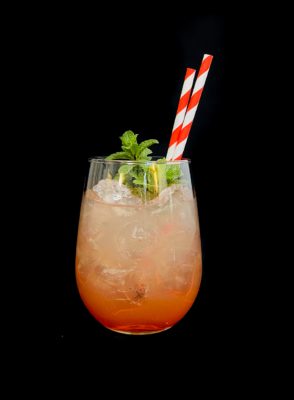
Negroni Americano
5.8% abv
The Americano, an original low-abv drink, is made with sweet vermouth, Italian bitters and soda water.
Sound familiar? The negroni was invented when Count Negroni swapped out the soda water in his Americano for gin making the drink a little boozier. Our Negroni Americano combines the best of both cocktails – a bit of our schnapps-forward wildbrumby Negroni and soda water. Bellissima!
Ingredients:
wildbrumby Negroni 45mL
Soda Water 140mL
Method: Add ice and wildbrumby negroni to a wine glass. Fill with soda water and garnish with dried orange slices or an orange wedge.
You can find our wildbrumby negroni here.
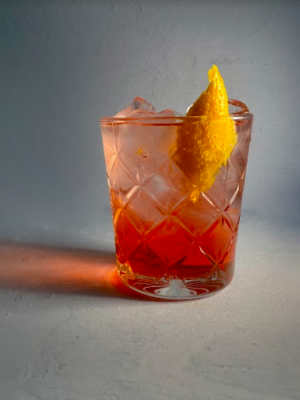
Peachy Tea
4.6% abv
Fancy sipping on a peachy tea on a sunny afternoon? We do too. Our award-winning peach nectar schnapps pairs perfectly with the citrusy notes of earl grey tea. You’ll never want an iced tea served any other way.
Ingredients:
45mL wildbrumby peach nectar schnapps 45mL
Peaches in Syrup (15mL syrup, 2 peach slices)
130mL Iced Earl Grey Tea
Method:
Prepare your iced earl grey tea by brewing 60mL of earl grey tea. Transfer the teabag and tea into a bottle of cool water and place in fridge till thoroughly mixed and chilled.
Build your cocktail by adding wildbrumby peach nectar schnapps, peach syrup, iced earl grey tea and ice to a tall glass. Mix with a bar spoon and garnish with 2 slices of peach.
You can find our wildbrumby peach nectar here.
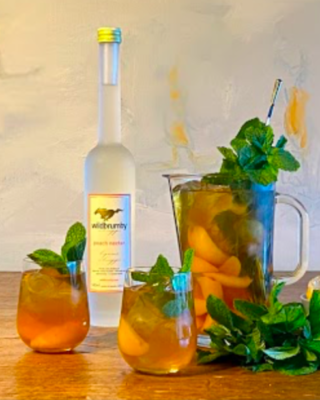
Our wildbrumby picnic hampers feature a sumptuous selection of goods from our own regional producers and providores.
The hampers can be pre-ordered 24-hours ahead of time for collection at the distillery.
You can browse our full range below and then contact us via email at info@wildbrumby.com to place your order.
GINdabyne Perfect Picnic Hamper
$110 (actual value $150)
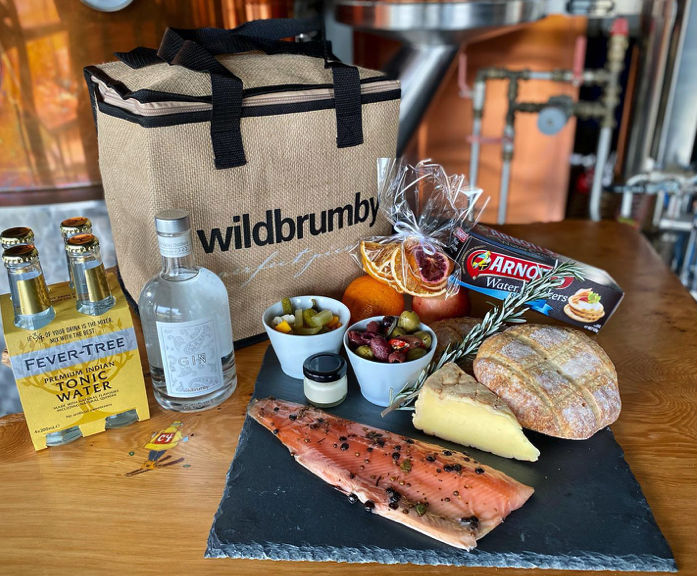
This perfect wildbrumby weekend treat includes:
A bottle of our Award-winning Classic Gin (500ml)
Four-pack of Fever-Tree Tonic + fresh and dried garnish to make the perfect G+T
Rockstock Deli local smoked Trout cured with our Gin Botanicals and wildbrumby horseradish aioli
Gruyere and Camembert Cheese
Freshly baked Ciabatta
Olives and Mixed Pickles + Crackers
Wildbrumby cooler bag
Picnic blanket
Wildbrumby Perfect Home Picnic
$90 (actual value $140)
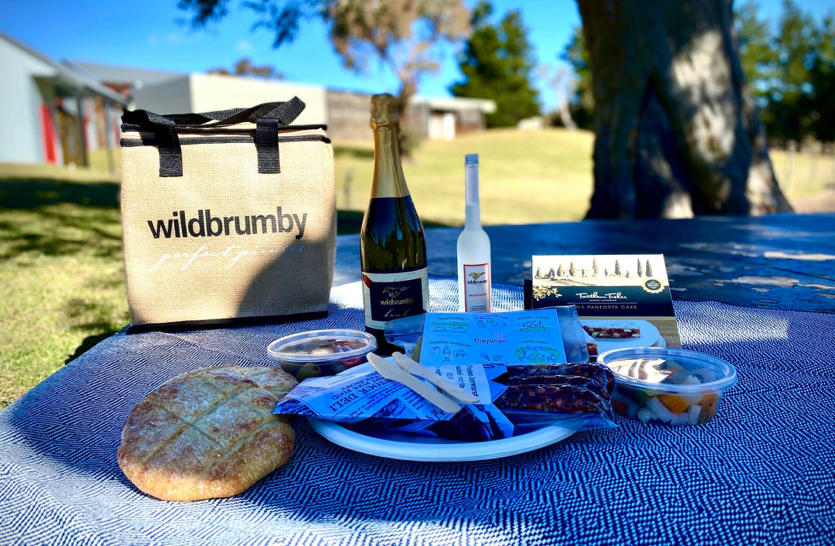
This very yummy home picnic pack includes:
1 bottle of Wildbrumby Brut
A 100ml Bottle of Peach schnapps (to make the perfect Bellini)
1 Siena Panforte Cake
Freshly baked Ciabatta
Gruyere and Camembert Cheese
1 Rockstock Deli Venison Jagerwurst
Olives and mixed pickles
Wildbrumby Cooler Bag
Picnic Blanket
25 July 2021
Come and visit us on the wildbrumby stall at the Pialligo ‘Love Local’ market in Canberra on Sunday 25 June from 9am until 2pm. We’ll be bringing along our award-winning schnapps, gin, vodka, negroni and gluhwein. so please come and say hi!

 Shop
Shop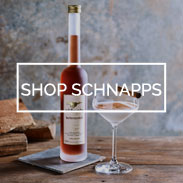 Shop Schnapps
Shop Schnapps Shop Gin
Shop Gin Stockists
Stockists Our Story
Our Story News
News Spalding Art
Spalding Art Distiller’s Blog
Distiller’s Blog Schnapps Distilling
Schnapps Distilling Gin Distilling
Gin Distilling Gallery
Gallery Distillery Door & Cafe
Distillery Door & Cafe Sculpture & Garden Walk
Sculpture & Garden Walk Contact
Contact Join Our Team
Join Our Team Join the Wildbrumby Club
Join the Wildbrumby Club